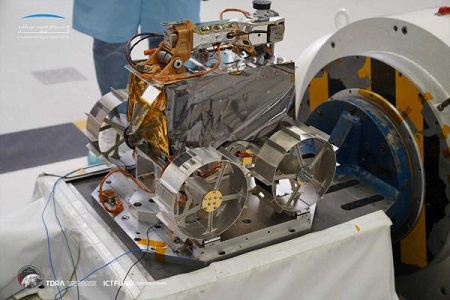On board a SpaceX Falcon 9 rocket, the mission is expected to launch next month from Cape Canaveral, Florida.
 Mohammed bin Rashid Space Centre (MBRSC) has announced that the Explorer Rashid team has completed the final stage of the tests, the last step separating the explorer from the launch date for the completion of the Emirates Moon Exploration Project, the first Emirati mission to the surface of the moon.
Mohammed bin Rashid Space Centre (MBRSC) has announced that the Explorer Rashid team has completed the final stage of the tests, the last step separating the explorer from the launch date for the completion of the Emirates Moon Exploration Project, the first Emirati mission to the surface of the moon.
Commenting on the development, Salem Humaid Al Marri, Director General of the Mohammed bin Rashid Space Center, said: “We congratulate and thank all members of the team who worked hard and diligently during the past period of tests with the aim of making the Emirates project to explore the moon a success, which will constitute a new scientific qualitative leap for the United Arab Emirates, and will pave the way for more Future space exploration missions, as this project embodies the spirit of innovation and scientific progress that characterises the UAE and its contribution to research and explorations of global space sciences.”
Dr Hamad Al Marzouqi, Director of the Emirates Lunar Exploration Project, added: “All of us at the MBRSC are waiting for this long-awaited moment, after we have completed the testing stages, and today we are preparing to move on to the next and final stage of our mission before launch, which includes placing the explorer in the launch rocket.”
He added: “We stress the importance of the sciences and technological technologies that have been applied in the Emirates project to explore the moon and their role in providing an answer to several questions related to the geology of the lunar surface, which we have worked on for years.”
Beginning of the year, the ELM rover completed the assembly and first set of full functional tests of the flight model in the laboratories of MBRSC. This phase of testing included assessments of all the functionality of the hardware and software within all the possible on-surface (lunar) scenarios.
This phase also included a heavy vibration test of the model at the EDGE’s Electro-Optics Centre of Excellence (EOCE) laboratories based in Abu Dhabi.
In the second phase, the Rashid rover completed a series of environmental tests at Toulouse, France. This included two sections of the evaluation: the first was the final thermal and vacuum tests within the Airbus facility, in which the Rover was heated and cooled to simulate the pressures and temperatures of its journey through space and on the moon’s surface.
The tests campaign concluded in Germany with the final phase of checks on the interfaces with the ispace lander that will safely deliver the rover to the Moon’s surface. This phase also included instrument alignment checks, such as imaging systems, and a final functional test of the integrated system following the environmental campaign.
Dr Hamad AlMarzooqi, Project Manager of the Emirates Lunar Mission, commented: “MBRSC can’t wait to see Rashid rover begin its long-awaited flight to the moon. We are now all cleared and ready for the next step, which is the launch vehicle integration process, which is the final stage of our lunar mission before launch. The science and technology of this mission are going to help us address major questions about the geologic and surface science of the moon that we’ve been working on for years, and we’re excited to share our journey with the world.”
Rashid Rover is now ready for the final integration process with the launch vehicle before its launch window of November 9 15, 2022 at the earliest. Built by Emirati minds within the state-of-the-art laboratories of MBRSC based in the UAE, the rover is equipped with the latest technologies and a deliberated design to enable all the planned scientific research work.
The primary goal of the mission is to study the moon’s plasma and to provide answers about moon dust, the lunar surface, mobility on the moon’s surface, and how different surfaces interact with lunar particles.
ELM is one of the missions funded by the ICT Fund of the Telecommunications and Digital Government Regulatory Authority (TDRA).










































































